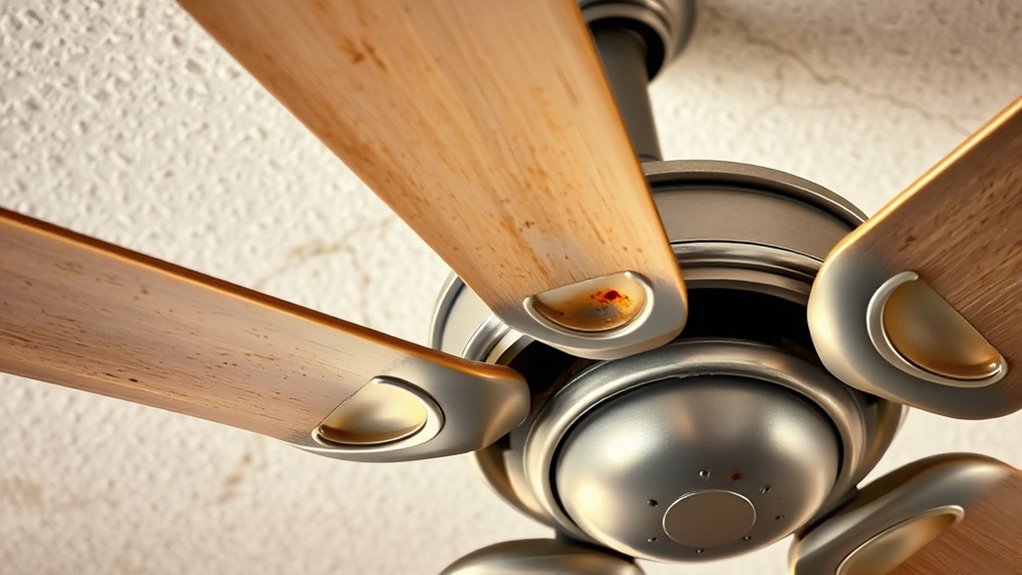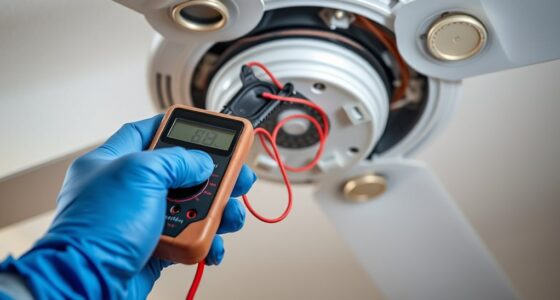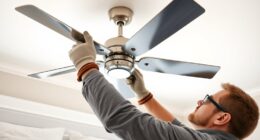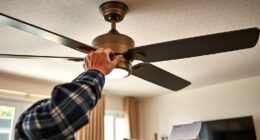Deciding whether to repair or replace your ceiling fan depends on its age, condition, and safety concerns. If the fan is over 10-15 years old or costs more than half the price of a new unit to repair, replacement is usually more practical. Wobbling, noisy operation, or electrical issues also suggest replacing for safety and efficiency. For detailed guidance on evaluating your specific situation, consider the factors that influence long-term performance and reliability.
Key Takeaways
- Consider the fan’s age; fans over 10-15 years may be more cost-effective to replace.
- Repair costs exceeding 50% of new fan prices often favor replacement.
- Persistent wobbling, noise, or safety issues indicate the need for replacement.
- Upgrading to a modern fan enhances energy efficiency and safety features.
- Repairing an old, unsafe fan can pose fire hazards and might not be worthwhile long-term.

When deciding whether to repair or replace a ceiling fan, it’s essential to assess the extent of the malfunction and the age of the unit. This evaluation determines whether repair costs are justified or if replacement offers a more reliable, long-term solution. Begin by diagnosing the specific issue. Common problems include persistent wobbling, unusual noises, inconsistent speed settings, or failure to operate altogether. Wobbling often results from misaligned blades, loose mounting hardware, or imbalanced blades, which are typically straightforward fixes. Noises, such as humming or rattling, can stem from electrical issues, loose components, or worn bearings, each requiring different levels of intervention. Analyzing the root cause helps establish whether a simple repair suffices or if deeper mechanical or electrical repairs are needed.
Assessing fan age and malfunction severity guides repair versus replacement decisions effectively.
Next, consider the age of your ceiling fan. Most units are designed to last around 10 to 15 years, depending on usage and maintenance. If your fan is nearing or exceeding this range, repair costs might outweigh the benefits, especially if multiple components are failing or if the motor shows signs of wear. Older units are also less energy-efficient compared to modern models, which incorporate advanced technology for better airflow and lower power consumption. In such cases, replacing the fan with a newer, more efficient model can result in energy savings that offset initial costs over time.
Evaluate the cost of repairs versus replacement. Repairing a ceiling fan involves replacing damaged blades, tightening hardware, lubricating bearings, or upgrading electrical components. These repairs can range from minimal expenses for blade balancing to significant costs for motor replacements. If repairs approach or exceed 50% of the cost of a new unit, replacement becomes more advantageous. Additionally, consider the availability of replacement parts; after several years, certain components may become obsolete, complicating repairs and increasing costs.
Finally, factor in safety and reliability. An aging fan with worn bearings or frayed wiring poses safety risks, including electrical fires or falling blades. If the fan’s structural integrity or electrical system is compromised beyond simple repairs, replacing it ensures compliance with current safety standards, reducing liability and potential hazards. New models also often feature improved safety features, such as better grounding and quieter operation, providing a safer and more comfortable environment.
Frequently Asked Questions
How Much Does Professional Ceiling Fan Repair Typically Cost?
Professional ceiling fan repair typically costs between $75 and $200, depending on the complexity of the issue. Basic repairs, like replacing a switch or fixing wiring, are usually on the lower end. More complex problems, such as motor replacement or significant wiring issues, can push costs toward the higher end. Factors like location, technician rates, and parts needed influence the total expense. Always get a detailed estimate beforehand.
Can I Upgrade My Fan’s Features Without Replacing It?
Yes, you can upgrade your fan’s features without replacing it. You might install a smart control system for remote operation, add a more efficient light kit, or upgrade the blades with quieter, aerodynamically optimized options. Guarantee compatibility with your existing fan model, follow manufacturer instructions, and consider professional installation if necessary. These upgrades enhance functionality and efficiency without the need for complete replacement, saving you time and money.
What Are Signs My Ceiling Fan Wiring Is Unsafe?
Your ceiling fan wiring shows warning signs like frequent flickering lights, sparks, or a burning smell, signaling danger. Loose or exposed wires are the skeletons of unsafe electrical systems, risking shocks or fires. Discolored or melted wiring insulation indicates overheating, like a hidden storm brewing beneath the surface. If you notice these signs, turn off the fan, avoid using it, and consult a qualified electrician immediately to prevent potential hazards.
How Long Does a Ceiling Fan Usually Last Before Replacement?
A ceiling fan typically lasts 10 to 15 years with proper maintenance. Factors like usage frequency, environmental conditions, and quality influence its lifespan. Over time, components like motors or bearings may wear out, reducing efficiency and safety. If you notice persistent unusual noises, wobbling, or decreased airflow after several years, it’s advisable to contemplate replacement. Regular inspections can help determine if repairs can extend its service life or if a new unit is warranted.
Is It More Energy-Efficient to Repair or Replace an Old Fan?
Ironically, repairing your old ceiling fan isn’t always the most energy-efficient choice. Modern fans feature advanced motors and blade designs that consume less power, making replacements generally more economical in the long run. If your current fan is outdated or requires frequent repairs, upgrading can reduce energy bills and environmental impact. As a result, investing in a new, energy-efficient model typically provides better efficiency than patching up an aging, inefficient fan.
Conclusion
Ultimately, determining whether to repair or replace your ceiling fan hinges on evaluating cost, safety, and efficiency. Scientific studies show that modern replacements often consume less energy and offer enhanced safety features, making them a practical choice for long-term savings. If repairs exceed 50% of the replacement cost or safety concerns arise, replacement is advisable. By analyzing these factors objectively, you guarantee ideal performance, safety, and energy efficiency, aligning your decision with evidence-based best practices.









